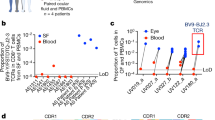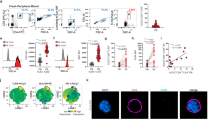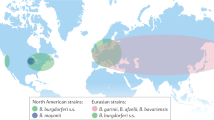Abstract
A novel ‘multistep molecular mimicry’ mechanism for induction of rheumatoid arthritis (RA) by bacterial antigens that activate T lymphocytes previously ‘educated’ by peptides derived from a class of human histocompatibility antigens is reported here. These antigens have the amino acid sequence QKRAA, which is also present on the Escherichia coli heat-shock protein dnaj. Synovial fluid cells of early RA patients have strong immune responses to the bacterial antigen, but cells from normal subjects or controls with other autoimmune diseases do not. The activated T cells may cross-react with autologous dnaj heat-shock proteins that are expressed at synovial sites of inflammation. Our findings may have direct relevance to new strategies for the immune therapy of RA.
This is a preview of subscription content, access via your institution
Access options
Subscribe to this journal
Receive 12 print issues and online access
$209.00 per year
only $17.42 per issue
Buy this article
- Purchase on Springer Link
- Instant access to full article PDF
Prices may be subject to local taxes which are calculated during checkout
Similar content being viewed by others
References
Spector, T.D. Rheumatoid arthritis. Rheum. Dis. Clin. N. Am. 16, 513–37 (1990).
Harris, E.D. Jr. Rheumatoid arthritis. Pathophysiology and implications for therapy. New Engl. J. Med. 322, 1277–1289 (1990).
Ollier, W. & Thomson, W. Population genetics of rheumatoid arthritis. Rheum. Dis. Clin. N. Am. 18, 741–761 (1992).
Winchester, R., Dwyer, E. & Rose, S. The genetic basis of rheumatoid arthritis: The shared epitope hypothesis. Rheum. Dis. Clin. N. Am. 18, 761–785 (1992).
Ashton-Rickardt, P.G. et al. Evidence for a differential avidity model of T cell selection in the thymus. Cell 76, 651–663 (1994).
Hogquist, K.A. et al. T cell receptor antagonist peptides induce positive selection. Cell 76, 17–27 (1994).
Allen, P.M. Peptides in positive and negative selection: A delicate balance. Cell 76, 593–596 (1994).
Chicz, R.M. et al. Specificity and promiscuity among naturally processed peptides bound to HLA-DR alleles. J. exp. Med. 178, 27–47 (1993).
Bardwell, J.C. et al. The nucleotide sequence of the Escherichia coli K12 dnaJ+ gene. A gene that encodes a heat shock protein. J. biol. Chem. 261, 1782–1785 (1986).
Van Asseldork, M., Simons, M., Visser, H., de Vos, W.M. & Simons, G. Cloning nucleotide sequence and regulatory analysis of the Lactococcus lactis dnaJ gene. J. Bacteriol. 175, 1637–1644 (1993).
Froude, J., Gibofsky, A., Buskirk, D.R., Khanna, A. & Zabriskie, J.B. Cross-reactivity between streptococcus and human tissue: A model of molecular mimicry and autoimmunity. Curr. Topic. Microbiol. Immunol. 145, 5–26 (1989).
Sieper, J. et al. Synovial T lymphocyte-specific immune response to Chlamydia trachomatis in Reiter's disease. Arthritis Rheum. 34, 588–598 (1991).
Van Eden, W. Heat shock proteins as immunogenic bacterial antigens with the potential to induce and regulate autoimmune arthritis. Immunol. Rev. 121, 5–28 (1991).
Life, P.F., Bassey, E.O. & Gaston, J.S. T-cell recognition of bacterial heat shock proteins in inflammatory arthritis. Immunol. Rev. 121, 113–135 (1991).
Winfield, J.B. & Jarjour, W.N. Heat shock proteins and arthritis. Bull. Rheum. Dis. 41, 4–5 (1992).
Olerup, O. & Zetterquist, H. HLA-DR typing by PCR amplification with sequence specific primers (PCR-SSP) in 2 hours: An alternative to serologic DR typing in clinical practice including donor-recipient matching in cadaveric transplantation. Tissue Antigens 39, 225–235 (1992).
Thomson, W. & Ollier, W. Non-radioactive ASO typing for class II-the way forward. Eur. J. Immunogenet. 19, 169–175 (1992).
Silman, A.J. et al. Twin concordance rates for rheumatoid arthritis: Results from a nationwide study. Br. J. Rheum. 32, 903–907 (1993).
Nepom, G.T. & Nepom, B.S. Prediction of susceptibility to rheumatoid arthritis by human leukocyte antigen genotyping. Rheum. Dis. Clin. N. Am. 18, 785–792 (1992).
Weyand, C.M., Hicok, K.C., Conn, D.L. & Goronzy, J.J. The influence of HLA-DRB1 genes on disease severity in rheumatoid arthritis. Ann. intern. Med. 117, 801–806 (1992).
Albani, S. et al. Immune responses to the E. coli dnaJ heat shock protein in juvenile rheumatoid arthritis correlate with disease activity. J. Pediatr. 124, 561–566 (1994).
Roudier, J. et al. Tolerance to a self peptide from the third hypervariable region of the Es beta chain. Implications for molecular mimicry models of autoimmune disease. Eur. J. Immun. 21, 2063–2067 (1991).
Roudier, J., Peterson, J., Rhodes, G.H., Luka, J. & Carson, D.A. Susceptibility to rheumatoid arthritis maps to a T-cell epitope shared by the HLA Dw4 DR beta 1 chain and the Epstein-Barr virus glycoprotein gp110. Proc. natn. Acad. Sci. U.S.A. 86, 5104–5108 (1989).
Salvat, S. et al. Tolerance to a self-peptide from the third hypervariable region of HLA DRB1*0401 in rheumatoid arthritis patients and normal subjects. J. Immun. 152, 5321–5329 (1994).
Chellaiah, A. et al. Cloning of a unique human homologue of the Escherichia coli dnaJ heat shock protein. Biochem. biophys. Acta. 117, 111–113 (1993).
Oh, S., Iwahori, A. & Kato, S. Human cDNA encoding dnaJ protein homologue. Biochem. biophys. Acta. 117, 114–116 (1993).
Fatenejad, S., Mamula, M.J. & Craft, J. Role of intermolecular/intrastructural B- and T-cell determinants in the diversification of autoantibodies to ribonucleoprotein particles. Proc. natn. Acad. Sci. U.S.A. 90, 12010–12014 (1993).
Nelson, N.L. et al. Maternal-fetal disparity in HLA class II alloantigens and the pregnancy-induced amelioration of rheumatoid arthritis. New Engl. J. Med. 329, 466–471 (1993).
Muller-Fassbender, H.R. A 6-month randomized dose range study of OM-8980 in rheumatoid arthritis. Br. J. Rheum. 32, 746–750 (1993).
Chen, Y., Kuchroo, V.K., Inobe, J., Hafler, D.A. & Weiner, H.L. Regulatory T cell clones induced by oral tolerance suppression of autoimmune encephalomyelitis. Science 265, 1237–1240 (1994).
Albani, S., Tuckwell, J.E., Esparza, L., Carson, D.A. & Roudier, J. The susceptibility sequence to rheumatoid arthritis is a cross-reactive B cell epitope shared by the Escherichia coli heat shock protein dnaJ and the histocompatibility leukocyte antigen DRB10401 molecule. J. clin. Invest. 89, 327–331 (1992).
Chicz, R.M. et al. Predominant naturally processed peptides bind to HLA-DR1 are derived from MHC-related molecules and are heterogeneous in size. Nature 358, 764–768 (1992).
Author information
Authors and Affiliations
Rights and permissions
About this article
Cite this article
Albani, S., Keystone, E., Nelson, J. et al. Positive selection in autoimmunity: Abnormal immune responses to a bacterial dnaJ antigenic determinant in patients with early rheumatoid arthritis. Nat Med 1, 448–452 (1995). https://doi.org/10.1038/nm0595-448
Received:
Accepted:
Published:
Issue Date:
DOI: https://doi.org/10.1038/nm0595-448
This article is cited by
-
Juvenile idiopathic arthritis
Nature Reviews Disease Primers (2022)
-
Circulating heat shock protein 90 (Hsp90) and autoantibodies to Hsp90 are increased in patients with atopic dermatitis
Cell Stress and Chaperones (2021)
-
Diversity in heat shock protein families: functional implications in virus infection with a comprehensive insight of their role in the HIV-1 life cycle
Cell Stress and Chaperones (2021)
-
Human Hsp40 proteins, DNAJA1 and DNAJA2, as potential targets of the immune response triggered by bacterial DnaJ in rheumatoid arthritis
Cell Stress and Chaperones (2013)
-
Recognition of self-heat shock protein 60 by T cells from patients with atopic dermatitis
Cell Stress and Chaperones (2013)



